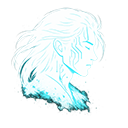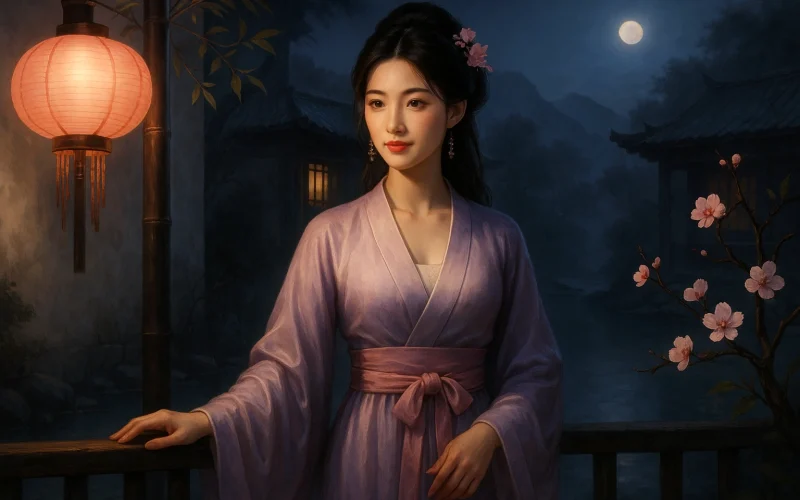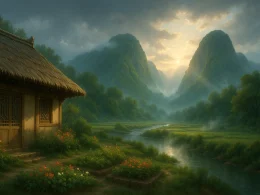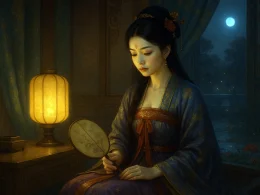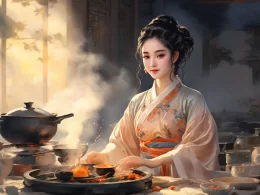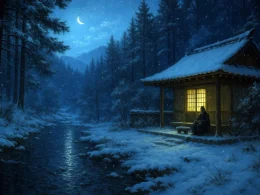The road to Zhang's forsaken tower—
Plum blossoms rot upon the bough,
Peach trees bleed their first flowers.
Lanes lie choked with silence,
Swallows nest in skull-shaped eaves.
I freeze in sepulchral trance,
Haunted by her ghost—that foolish child,
Who peered through death's gate at dawn.
Her brow smeared with grave-gold,
Shroud-sleeves fluttering, laughter like dying chimes.
I, the doomed Liu Lang, return,
Knocking on tombs where dancers once trod.
Only Qiu Niang's corpse remains,
Her price still paid in phantom coin.
Our poems—I recite "Yan Terrace" like a curse.
What demon walks with her now?
What shadow sips dew in cursed groves?
All consumed by the vampiric wild goose.
My spring is but a funeral,
Parting's eternal wound.
Willows hang their gilded nooses.
My nightmare steed stumbles home,
As acid rain scars the black pond.
This courtyard is my hell—
A shroud of wind-whipped ashes.
Original Poem
「瑞龙吟 · 大石春景」
章台路,还见褪粉梅梢,试花桃树。
愔愔坊陌人家,定巢燕子,归来旧处。黯凝伫,因念个人痴小,乍窥门户。
侵晨浅约宫黄,障风映袖,盈盈笑语。前度刘郎重到,访邻寻里,同时歌舞。
周邦彦
惟有旧家秋娘,声价如故。吟笺赋笔,犹记《燕台》句。
知谁伴、名园露饮,东城闲步?
事与孤鸿去。探春尽是,伤离意绪。
官柳低金缕。归骑晚、纤纤池塘飞雨。
断肠院落,一帘风絮。
Interpretation
Composed in 1097 upon Zhou Bangyan's return to the capital after a decade-long political exile, this ci poem was written during his tenure as Director of the Imperial Academy. Revisiting familiar haunts near the Great Stone Bridge and Zhangtai Road—once vibrant centers of romantic and cultural life—the poet finds the physical landscape unchanged but human connections irrevocably altered. Through layered recollections of a vanished world, the work transforms personal nostalgia into a meditation on time's erosions, where spring's cyclical return only underscores life's linear losses.
First Movement: "章台路,还见褪粉梅梢,试花桃树。愔愔坊陌人家,定巢燕子,归来旧处。"
Zhāng tái lù, hái jiàn tuì fěn méi shāo, shì huā táo shù. Yīn yīn fāng mò rén jiā, dìng cháo yàn zi, guī lái jiù chù.
Zhangtai Road again—
plum blossoms shedding powder,
peach trees testing first blooms.
Lanes lie hushed beneath eaves
where swallows still return
to their accustomed beams.
The opening establishes temporal dissonance through botanical markers. "Shedding plum blossoms" (褪粉梅梢) symbolize fading beauty and elapsed time, while "testing peach blooms" (试花桃树) represent emergent vitality. The "hushed lanes" (愔愔坊陌) and returning swallows mirror nature's cyclical fidelity against human transience—avian homing instincts highlighting the poet's own displaced condition. This contrast between seasonal renewal and personal irretrievability sets the poem's central tension.
Second Movement: "黯凝伫,因念个人痴小,乍窥门户。侵晨浅约宫黄,障风映袖,盈盈笑语。"
Àn níng zhù, yīn niàn gè rén chī xiǎo, zhà kuī mén hù. Qīn chén qiǎn yuē gōng huáng, zhàng fēng yìng xiù, yíng yíng xiào yǔ.
I stand transfixed,
recalling how she peered shyly
through her crimson gate—
dawn-lit in pale court-yellow,
sleeves fluttering against the breeze,
laughter like strung pearls.
This cinematic flashback crystallizes ephemeral intimacy. The woman's "crimson gate" (门户) suggests both physical threshold and erotic symbolism, while "court-yellow" (宫黄) makeup hints at her courtesan status. The synesthetic "laughter like strung pearls" (盈盈笑语) transforms sound into tangible treasure, attempting to preserve fleeting joy through poetic alchemy. Zhou's genius lies in making this momentary glimpse—a half-seen face at dawn—embody all lost beauty.
Third Movement: "前度刘郎重到,访邻寻里,同时歌舞。惟有旧家秋娘,声价如故。吟笺赋笔,犹记《燕台》句。知谁伴、名园露饮,东城闲步?事与孤鸿去。探春尽是,伤离意绪。官柳低金缕。归骑晚、纤纤池塘飞雨。断肠院落,一帘风絮。"
Qián dù Liú láng chóng dào, fǎng lín xún lǐ, tóng shí gē wǔ. Wéi yǒu jiù jiā Qiū niáng, shēng jià rú gù. Yín jiān fù bǐ, yóu jì "Yàn tái" jù. Zhī shuí bàn, míng yuán lù yǐn, dōng chéng xián bù? Shì yǔ gū hóng qù. Tàn chūn jìn shì, shāng lí yì xù. Guān liǔ dī jīn lǚ. Guī qí wǎn, xiān xiān chí táng fēi yǔ. Duàn cháng yuàn luò, yī lián fēng xù.
Like Liu Chen returning,
I seek old haunts and songmates—
only Qiu Niang remains
with undiminished fame.
My verse still recalls
those "Swallow Terrace" lines.
Who now shares her garden cups
or east-town strolls? All
with lone geese flown. Spring's
beauty breeds parting's sorrow.
Willows droop golden threads.
My late-returning horse
meets pond-side drizzle.
The heartbreak courtyard
veiled in windblown catkins.
The finale weaves literary allusions into existential lament. "Liu Chen" (刘郎) references the immortal who returned to find centuries elapsed—a metaphor for the poet's own belated homecoming. The enduring courtesan Qiu Niang (秋娘) becomes time's ironic witness, her unchanged reputation highlighting the poet's emotional devastation. The "Swallow Terrace" (燕台) allusion to Li Shangyin's poems about unrequited love deepens the intertextual melancholy. Nature's cyclical beauty ("golden willows", "pond-side drizzle") contrasts with human irrevocability ("all with lone geese flown"), culminating in the devastating final image—a courtyard choked with catkins (风絮), ephemeral as both memory and desire.
Holistic Appreciation
Zhou constructs a palimpsest of temporal layers: present revisit (first movement), past romance (second), and meditative synthesis (third). This structure mirrors traditional Chinese narrative arcs (起承转合) while achieving modernist temporal fluidity. The poem's central tension lies between botanical cycles (blossoming/fading trees, returning swallows) and human linearity (irrecoverable love, accumulating loss)—a tension resolved only through art's preservative power, as seen in the preserved "Swallow Terrace" verses that outlast their inspiration.
Artistic Merits
- Botanical chronometry
The "shedding plum blossoms" (褪粉梅梢) and "golden-thread willows" (官柳低金缕) serve as natural timepieces measuring emotional duration. - Cinematic flashback
The second movement's vignette—with its "crimson gate" framing and "strung pearls" soundtrack—demonstrates Zhou's narrative visuality. - Intertextual resonance
Liu Chen, Qiu Niang and Swallow Terrace allusions create a chorus of literary voices echoing the poet's lament. - Meteorological pathos
The concluding "pond-side drizzle" (池塘飞雨) and "windblown catkins" (一帘风絮) externalize sorrow through delicate precipitation.
Insights
Zhou's poem reveals memory as both wound and salve—the "heartbreak courtyard" (断肠院落) is simultaneously a site of pain and the only remaining connection to lost joy. This paradox informs the modern condition: our most cherished memories are often those that hurt the most to recall.
The work also suggests that artistic creation stems from lack—the preserved "Swallow Terrace" verses exist precisely because the love they commemorate is gone. For contemporary creators, this underscores how loss fuels art, and how art attempts the impossible: to stop time's flow through aesthetic crystallization.
Ultimately, the poem presents nostalgia not as passive longing but as active archaeological labor—the poet "seeking old haunts" (访邻寻里) like an excavator sifting cultural strata. In our age of rapid obsolescence, Zhou reminds us that true homecoming is never geographical, but always an excavation of layered selves across time's sediment.
About the Poet
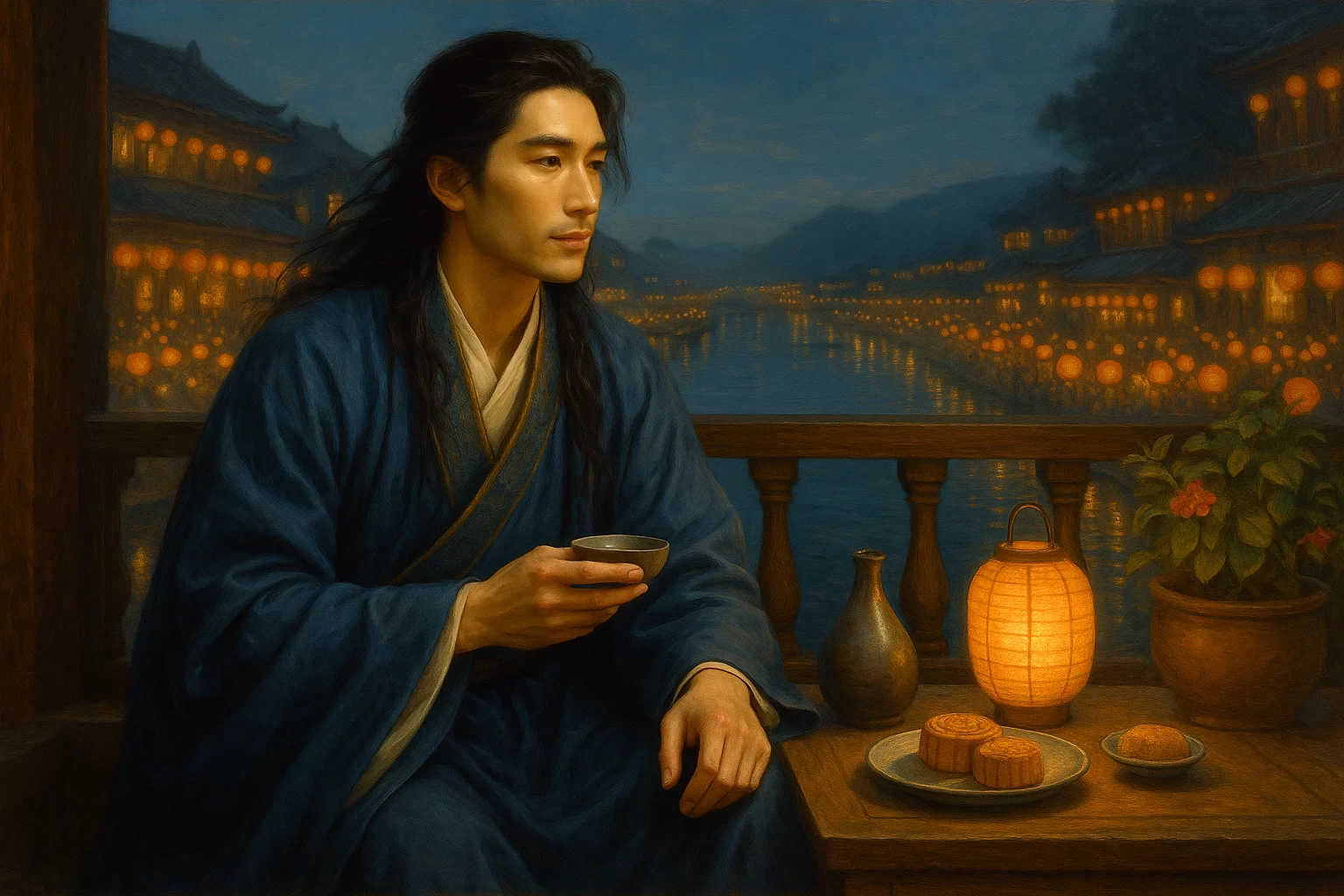
Zhou Bangyan (周邦彦 1056 - 1121), a native of Qiantang (modern Hangzhou, Zhejiang), was the culminating master of the wanyue (graceful and restrained) ci poetry of the Northern Song Dynasty. A virtuoso in musical temperament, his ci are renowned for their opulent refinement and technical perfection. He created dozens of new melodic patterns (cipai) and adhered to strict tonal rules, earning him the title "Crown of Ci Poets." His influence extended to Southern Song masters like Jiang Kui and Wu Wenying, establishing him as the founding patriarch of the Rhymed Ci School.

